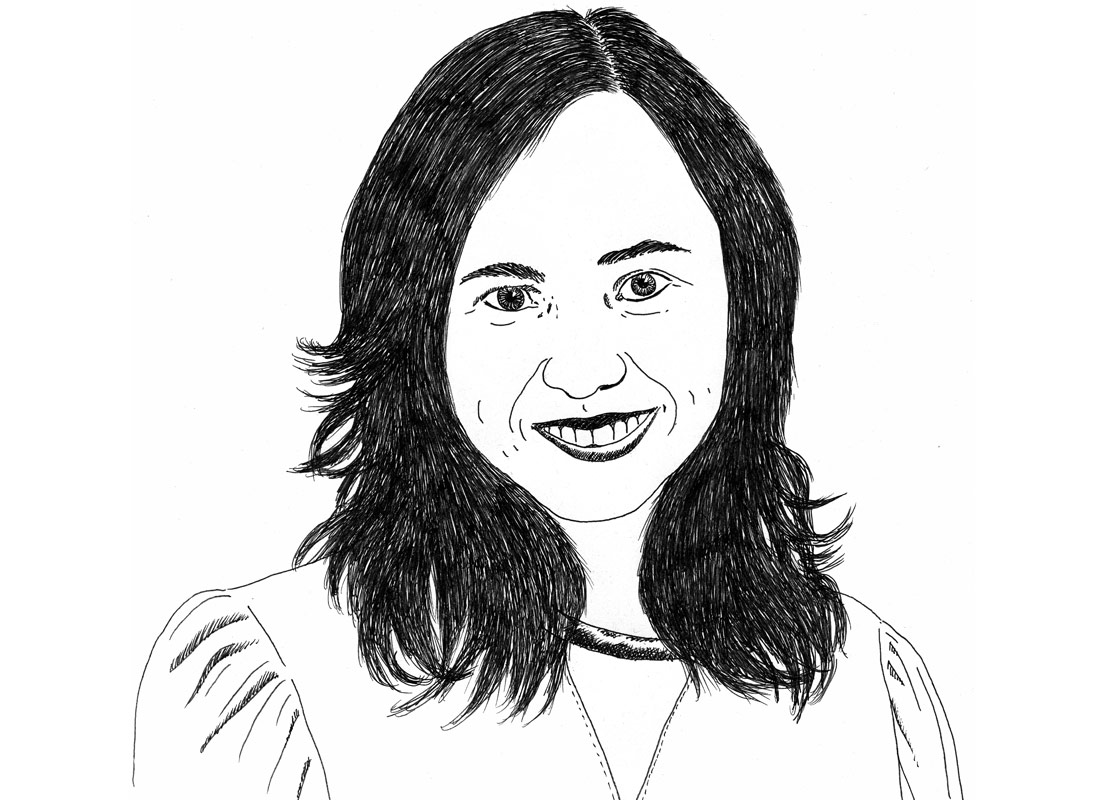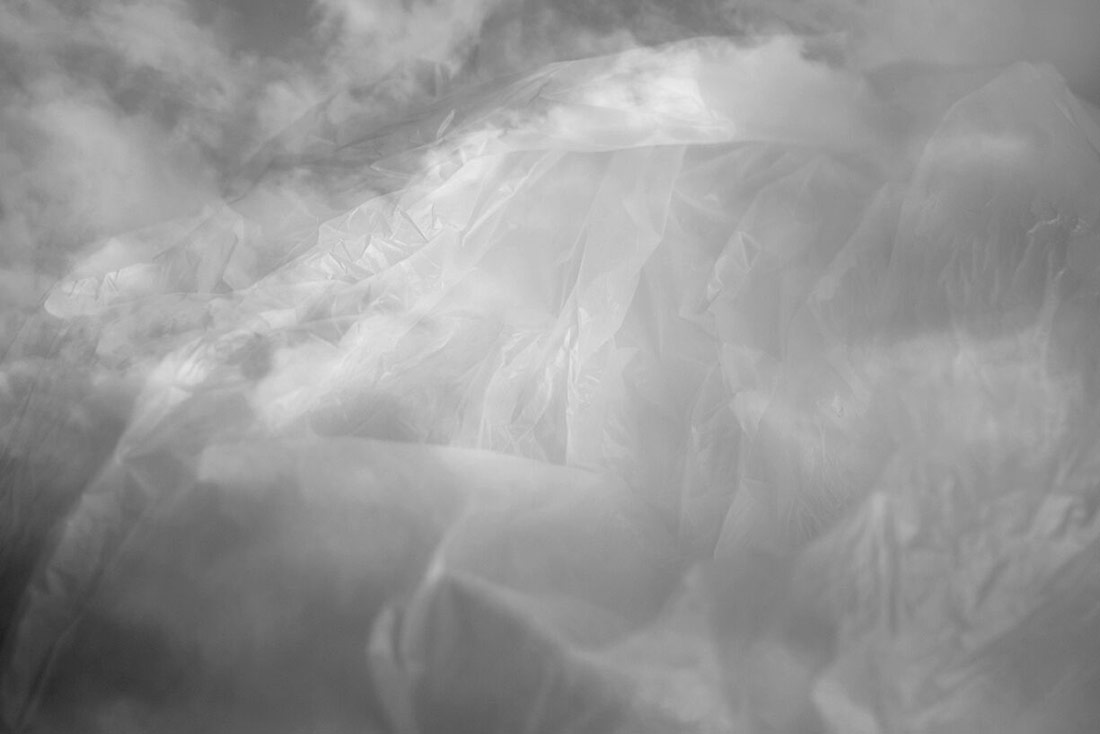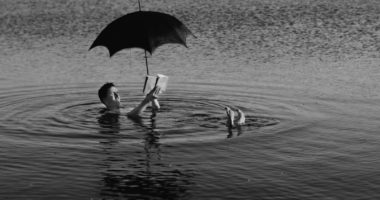
Joanna Zylinska | Illustration by de José Antonio Soria | CC-BY
Can we change the way we live, here and now? In her book Minimal Ethics for the Anthropocene, Joanna Zylinska proposes to look at the Anthropocene from an ethical viewpoint in order to create a narrative that avoids apportioning blame and proposing individualist solutions, and that focuses on our shared responsibilities instead. We talk to Joanna about her notion of minimal ethics, about a feminist counterapocalypse, and about her work in various media.
Minimal Ethics for the Anthropocene entails a proposition to put the question of ethics on the current agenda. It consists of “shards of thoughts” which are inspired by Adorno’s Minima Moralia: Reflections from Damaged Life. Your ethical proposal consists of a demand for a response, not just a reaction, but it is also non-systemic and non-normative: you call it a philosophical proposition for non-philosophers. Can you describe this proposal in relation to the Anthropocene?
What I was trying to do with this book is develop a vocabulary and a mode of thinking in response to the issues surrounding climate change, the depletion of the earth, the logic of extractivism that is reliant on coal and oil, and our extreme use of natural resources – which are quickly running out. In the process of my research I became aware of all these narratives, or stories, about the Anthropocene. To call them “stories” is not to say that they aren’t connected to scientific facts, but rather to highlight their discursive nature, that is the fact that they rely on multiple figurations and tropes. I was also interested, as a philosopher and cultural theorist, in how I could develop a response, or a mode of seeing the phenomenon of the Anthropocene, in a way that was persuasive and that actually did something. And I wanted to do it in a vocabulary and a mode of thinking that would sit comfortably with me, but also with many different audiences, including my students. Hence my Minimal Ethics for the Anthropocene.
A lot of the discussions around the Anthropocene, climate change and all these other issues I mentioned earlier have been primarily political (or anti-political, as the case may be, with Trump threatening to withdraw from the climate change agreements). Or they have taken a technocratic slant, with various experts rushing in to offer quick fixes: e.g. Silicon Valley proposing all sorts of solutions to extend the human lifespan, investing in the chemical purification of the oceans and in space reflectors to be used to reclaim some of the sun’s energy, or offering to take people to other planets – to Mars, for instance (see Elon Musk‘s proposal). And I was thinking, well, before we do any of this, before we go ahead with any of these ideas (ideas that I have many problems with), maybe we should first of all try and see the Anthropocene as a phenomenon and a discourse, that is, as a problem posed to us humans that we have to respond to somehow. For me this response should first of all be ethical, in the sense that the discourse on the Anthropocene, the narrative of the Anthropocene, primarily raises the issue of our human responsibility. So I see the Anthropocene as something that demands that we humans see ourselves in a different way, as a partial cause of those changes. But I also see the Anthropocene as an interpellation to challenge the human as the key subject of history. A lot of the narratives around the Anthropocene have actually been used to aggrandise the human, embracing this old modernist belief: “humans are so amazing, we have done so many things over the centuries and now, look, we’ve actually broken the planet, we’ve broken the earth!”. In my work there is therefore a gentle humorous attempt, which is very serious at the same time, to cut down to size this grandiosity of the human and this belief in our amazing might. I also want to develop what I call a “minimal narrative”, which, if I wasn’t so scared of using a religiously-inflected language, I would call a “narrative of humility”.
we should first of all try and see the Anthropocene as a phenomenon and a discourse, that is, as problem posed to us humans that we have to respond to somehow.
And related to this, you have remarked that we need better stories because stories have a performative nature in this “relational matrix”.
We do need better stories, and I also think we need better ways of seeing the Anthropocene. I am inspired here by the visual culture theorist Nicholas Mirzoeff, who says that the Anthropocene is something we can’t visualise. We are trying to envisage it and yet we can’t really see it because it has been unfolding over an extremely long period of time. So what happens is we come up with all these images that are supposed to give us a representation of the event: images of chimney stacks spewing out smoke or polar bears on ice caps melting around them. Yet in a sense we have become immune to images. It’s because images are everywhere: we see the next one, then the next one and yet another one – and nothing happens. Also, Mirzoeff says that we can’t actually ever see the Anthropocene because of its duration. What we do instead is reduce it to single snapshots, which at the end of the day don’t do anything for us because we have become desensitized by images. There is therefore arguably a need to develop a different story and a different way of seeing the Anthropocene. My proposal for a minimal ethics is one such attempt.
To go back to your earlier question about why this ethics is non-normative, it is because I don’t want to come up with some kind of “ten commandments” that would tell people how to live and what to do (“you have to recycle, you have to avoid this and promote that”), as that approach would still be very individualistic. And I am wary of individualistic solutions to global problems, as such an approach amounts to depoliticising global issues while taking responsibility away from the state, from institutions, from global capital, and pinning it on individuals. Then we end up in a ridiculous situation whereby me peeing in the shower or not using plastic water bottles is equivalent to what massive oil companies should be doing to protect the environment. I certainly don’t want to promote that kind of equivalence, and I think we need to look at the inequalities of power around it. But I also think that we are faced here with a moral question: the understanding of differences within the Anthropocene stories. A better story would be a story that makes such power distinctions visible. Otherwise there is a danger of the Anthropocene becoming this kind of great leveller in which everyone is equally guilty. We have a responsibility to understand how those historically, geographically and economically diverse groups of humans have exerted power in different ways and with different consequences. The story I am proposing is non-normative because it doesn’t list any “approved” behaviours; instead, it “just” poses the question of responsibility – which, for me, is the most important question. Once the question has been posed, we are faced with a task, but we don’t need to rush towards any solutions yet. In a way, proposing to start with ethics before politics springs from a desire on my part to slow down our response – to think about the nature of the debate, its structuring and its vocabulary, and about the implied subject, object and problem. And to introduce reflection, instead of rushing towards solutionism, which is often coupled with a masculinist “gung-ho” approach, where we can pull ourselves up by the bootstraps of our rationality and our technology, and move on.
I am wary of individualistic solutions to global problems, as such an approach amounts to depoliticising global issues while taking responsibility away from the state, from institutions, from global capital, and pinning it on individuals.
In relation to the concept of life, you claim that tekhné is originary to life, rather than being a mere product of human activity. This conception implies different modulations of rationality – what you call “a post-masculinity rationality”. In September 2017, at the Ars Electronica Festival you mentioned that you were working on a project of a feminist counterapocalypse. Can you go into some more detail on this?
I recently finished writing this little book which is a follow-up to Minimal Ethics for the Anthropocene and which is called The End of Man: A Feminist Counterapocalypse. That book picks up this minimal imperative from the previous one, but it also engages less with philosophical discourses and more with popular culture and media, especially with the staging of the apocalypse in the media. We can see the apocalypse everywhere. For example, literary critic Frank Kermode has said that the discourses of the apocalypse are particularly long-lived: they keep coming back, we don’t seem to be able to get rid of the apocalypse. We can see this in TV programmes drawing on the end-of-the-world tropes, in films like Dolce Vita, or in novels such as those by Margaret Atwood. But there is something in the air now around a very particular re-imagination of the apocalypse. You can see it in the art world as well, with so many exhibitions about the Anthropocene being put on. Yet, important as it is to explore this topic in different modes and media, there is perhaps also a danger that such shows give us a certain pleasure while also performing an “anaesthetic function”, as Mirzoeff calls it. So the world is falling apart, or even coming to an end, and we are supposedly contributing to this state of events, and yet we have created a whole bunch of cultural products that allow us to experience the apocalypse, while also appeasing us into non-action.
A feminist counterapocalypse realises that these apocalyptic stories are used by those in power – very often men in power – to get what they want, in terms of the accumulation of capital and the promotion of various associated enterprises. The story goes that only the select few, which really means only the wealthiest, will survive and go on to repopulate the earth. The traditional capitalist argument claims that all benefits will cascade down and the poor will eventually have a better life too. Yet the logic of inequality and divisionism is clearly inscribed in the majority of solutions that have been proposed with regard to the Anthropocene, understood as a contemporary reiteration of the apocalypse. The apocalyptic narrative is typically premised on the belief that times are hard, so of course not everyone will make it but only a group of “special ones”. They used to be the sovereign, the King or Queen, but these days it’s those who are in charge of technology and innovation, who define what technology and innovation are and how they should operate, that are positioned as the survivalist caste – a group that will have the means to survive and that sees itself as destined to survive. So, my feminist counterapocalypse takes the traditional apocalyptic story but looks at it in the spirit of Donna Haraway, and also the feminist theologian Catherine Keller, who actually came up with the term “counter-apocalypse”. It allows me to approach the apocalyptic narrative somewhat ironically, to look at it slightly askew, from an angle, and think: “no, this can’t be true”. I’m also drawing on the work of Belgian philosopher Isabelle Stengers, who in her book In Catastrophic Times uses ideas from systems theory to explore how the earth’s systems are connected. This in turn allows her to cut the human down to size in the narrative we tell ourselves about the earth. With my counterapocalyptic project I am also inspired by the work of American theorist Anna Tsing, whose book The Mushroom at the End of the World: On the Possibility of Life in Capitalist Ruins explores the conditions of life after the end of industry on a global scale. She looks at stories of matsutake mushroom pickers in the forests of Oregon, who are immigrants from Laos and Cambodia, and also white Americans who have opted out, by choice or life circumstances, of traditional employment. Tsing perceives this precarious group of people who develop a life in the forest as staging a kind of alternative economy. Now, I am not suggesting that we should all move to the forest. But Tsing’s book is interesting because it offers a philosophical exploration, enacted in material terms, of what it means to accept the fact that precarity, or life in the ruins, is no longer something that only happens to a select few. That perhaps the way things are going, we will all end up living in a forest, real or metaphorical one, whether we like it or not. The forest could stand for the flooded areas of the city, for example. If the oceans and sea levels rise, you could end up with people having to scavenge for food, because it will become a scarce resource. So what is going to happen then? And shouldn’t we try and change the way we live here and now? Can we adopt some more collaborative ways of living with each other – and also with other species? By saying this I am not fantasising about some kind of happy communion of all species. There is a clear realisation that there appears a conflict, a form of violence, in all kinds of cohabitation. But what humans, with their relatively developed rationality and cognitive skills, and driven by the principles of justice and non-harm, can do is reflect on, and develop ways of, minimising this violence. For me a feminist counterapocalypse is not about some kind of paradise but rather about turning apocalyptic horror into a possible ethical scenario.
You insist on the importance of scale, saying that minimal ethics needs to work on a universal scale, yet it also needs to acknowledge how relations, entities and phenomena appear to us materially-grounded humans. Is focusing on scale an effective and affirmative way to avoid the distance generated by proposals based solely on an abstract theoretical framework?
The question of scale is absolutely important because a lot of the stories around the Anthropocene have been developed on a rather grand scale – the scale of deep or so-called geological time. I think it’s imperative for us to unlock ourselves from our own human anchor point and look at ourselves from space. But once we have done this we need to return and re-anchor ourselves again. We need to be aware of the scale, but we must not just whizz up and down it, as if we were disembodied creatures who can freely master the world and grasp it from every perspective. I’m interested in loosening things up, and in looking at ourselves and our environment from outside, so to speak. But I also want to pose Donna Haraway’s questions, such as: Whose vision is it? Where are we looking from? We need to do this to avoid what she calls a “god-trick” of infinite vision, which stands for “vision from everywhere”. So thinking in terms of scale also pushes us to probe who is doing the act of looking, who is doing the measuring, whose scale it is. Is my scale the same as the scale of the mushroom, or the scale of the planet? What kinds of ethical and political questions does this particular scale bring up?

Topia Daedala 11 | Joanna Zylinska, 2014
So, if I have understood it correctly, your concept of minimal ethics is not about solving paradoxes or synthesising different points of view from the outside, but rather about the material intra-implications of putting ourselves at risk, troubling ourselves, our ideas, embracing all the different ways of touching and being touched, and sensing the differences and entanglements from within. It’s a way of articulating minimal ethics through matter, as you do in your practice. We need to rethink ethics without accepting normative universals because minimal ethics is grounded, embodied and embedded. So what you call ethics here is therefore no longer about what we must do, but rather about how we are entangled? Or, with reference to Karen Barad, it’s about how we measure (up)?
Yes, that’s right. I am very much on the same page as Barad when it comes to understanding entanglement and interrogating how we measure things, how we inscribe ourselves into relationships and how we understand ourselves in them. The consequence of thinking in this way is both acknowledging certain material entanglements and producing concepts related to them. It’s also offering better articulations of theories of subjectivity and theories of emergence. This language here is borrowed from science but also from STS (Science and Technology Studies), from social theory, from cultural studies, and, last but not least, from feminist theory. All those different disciplines enact something between science and poiesis, or maybe even discover a certain poeticity of science, especially at that kind of open-ended level, where science itself is actually akin to philosophy, and where it can also generate narratives about the world. The point at which science comes to a halt, that is the edge of our current knowledge and understanding, is the point where it has to construct concepts to name things that it observes or postulates through equations.
Finally, could you tell us how you incorporate your work in different media into your philosophical thought?
To explore the ideas we’ve been discussing, I work with a number of other media beyond just the medium of language, as you know from my book Minimal Ethics, which includes images from my own art practice and which continues my visual exploration of various forms of manufactured landscape. I also adopt this approach in my short film Exit Man, based on what I call my “Local Museum of the Anthropocene”, which includes different kinds of images I have been collecting for years. With my visual practice I am not attempting to just illustrate a theoretical argument but rather to give images and visuality the same valence that words have and to think about how we can philosophise with different media. I am aware that different media have different outcomes, different affordances if you like, but I am interested in opening up the philosophical discourse to other modes of thinking, which leads me to pose the following questions: How can you think with pictures? How do you make cuts to your arrangement of ideas and images? You literally make cuts when you take photographs, when you edit a film. So how does this change not just the way I think, but also philosophy in general? And how could you do philosophy with images, not just write and philosophise about images? So that’s my current desire, my current space for thinking with other media.
I must emphasise that I have great respect for language, for logical argument and for philosophy as a discipline with all its history, so I don’t want to throw the baby out with the bathwater of critique. For me it’s more about modulating, opening up and cross-pollinating the modes of enquiry. And if we are talking about all these hybrids and entanglements, we must recognise that philosophy is already entangled, so the question then becomes of how you can de-purify it a little bit without losing the rigour. I think this is a difficult task, and there is a danger that philosophy will look just like Instagram. We could easily fall into visual traps set upon us by the cultural industries. But I still think it’s a task worth undertaking: to try and un-lodge ourselves from particular ways of thinking and doing, and to start practicing what we might call a multisensory and multimedial philosophy.
Joanna Zylinska is a writer, lecturer, artist and curator, working in the areas of new technologies and new media, ethics, photography and art. She is Professor of New Media and Communications, and Co-Head of the Department of Media and Communications, at Goldsmiths, University of London. She is the author of seven books – most recently, The End of Man: A Feminist Counterapocalypse (University of Minnesota Press, 2018), Nonhuman Photography (MIT Press, 2017) and Minimal Ethics for the Anthropocene (Open Humanities Press, 2014; e-version freely available). Her translation of Stanislaw Lem’s philosophical treatise, Summa Technologiae, came out from the University of Minnesota’s Electronic Mediations series in 2013. Zylinska combines her philosophical writings with photographic art practice and curatorial work. In 2013 she was Artistic Director of Transitio_MX05 ‘Biomediations’: Festival of New Media Art and Video in Mexico City. Together with Clare Birchall and Gary Hall she runs the JISC-funded project Living Books about Life, consisting of a series of 20+ co-edited, electronic open access books about life which provide a bridge between the humanities and the sciences.



Leave a comment